Speed control : Here, you set whether the charge pump
will be regulated automatically or manually. Select "Auto"
for optimal operation.
Speed in standby mode: Here, you set the speed the
charge pump will have in standby mode. Standby mode
occurs when heating or cooling operation is permitted
at the same time as there is no need for either com-
pressor operation or electric additional heat.
Speed control charge pump: Here, you set whether the
charge pump is to be regulated automatically or via
manually controlled speed. Select "Auto" for optimal
operation.
Manual speed, charge pump: If you have opted to con-
trol the charge pump manually, you set the desired
pump speed here. (Settings are available per demand
heating/pool/hot water/cooling.)
Lowest permitted speed: Here, you can restrict the
pump speed, so the charge pump is not allowed to op-
erate at a lower speed than the set value.
Maximum permitted speed: Here, you can restrict the
pump speed, so the charge pump is not allowed to op-
erate at a higher speed than the set value.
MENU 7.1.2.5 - FLOW SETTING CHARGE
PUMP
Pump setting
Activate flow test
Activate flow test for charge pump (GP12) here
Flow setting charge pump
Check that the flow for the charge pump through the
heat pump is sufficient. Activate the flow test to meas-
ure delta (the difference between the flow and return
line temperatures from the heat pump). The test is OK
if delta lies below the parameter shown in the display.
If the temperature difference lies above the parameter,
adjust the flow for the charge pump by reducing the
pressure or in the worst case scenario replacing the
charge pump, until the test is OK.
MENU 7.1.5 - ADDITIONAL HEAT
This menu contains sub-menus where you can make
advanced additional heat settings.
MENU 7.1.5.1 - ADDITIONAL HEAT
Make settings for connected additional heat (step con-
trolled or shunt controlled additional heat) here.
Select whether step controlled or shunt controlled addi-
tional heat is connected. Then you can make settings
for the different alternatives.
Add. heat type: Step-contr
Add. heat type
Alternative: step controlled/shunt controlled
Location
Alternative: After/Before QN10
Additional heat in tank
Alternative: on/off
Activating immersion heater in heat.
Alternative: on/off
Max step
Setting range (binary stepping deactivated): 0 – 3
Setting range (binary stepping activated): 0 – 7
Binary stepping
Alternative: on/off
Location: Here you choose whether the step controlled
additional heat is located before or after the reversing
valve for hot water charging (QN10). Step controlled
additional heat is, for example, when an external electric
boiler is installed.
Additional heat in tank If an immersion heater is installed
in the tank, it can be permitted to produce hot water at
the same time as the heat pump prioritises heating or
cooling.
Max step: Here, you can set the maximum number of
permitted additional heat steps, if there is internal addi-
tional heat in the tank (only accessible if the additional
heat is positioned after QN10), whether binary stepping
is to be used, the size of the fuse and transformer ratio.
When binary stepping is deactivated (off) the settings
refer to linear stepping. If the additional heat is placed
after QN10, the number of steps is restricted to two
linear or three binary.
Add. heat type: Shunt-contr
Add. heat type
Alternative: step controlled/shunt controlled
Prioritised add. heat
Alternative: on/off
Minimum operating time
Setting range: 0 – 48 h
Lowest temperature
Setting range: 5 – 90 °C
Shunt amplification
Setting range: 0.1 –10.0
Shunt waiting time
Setting range: 10 – 300 s
53Chapter 9 | Control – MenusNIBE SMO S40

